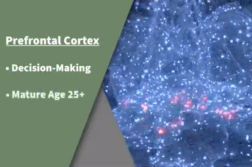HACKENSACK, N.J. (Ivanhoe Newswire)— About 13,000 Americans will be diagnosed with glioblastoma this year and 10,000 people with glioblastoma will die. Now, neuro-oncologists are testing a tumor treating helmet-like device in pediatric patients. It’s designed to stop cancer cells from dividing and taking hold again. Ivanhoe reports.
Ivan Galeano was with his mother when the normally healthy teen felt his left pinky go numb.
“And then from there it started spreading to the hand and into the arm,” explained Ivan.
“I thought at first this is like a heart attack. He thought it was a heart attack. So, he started screaming,” shared Vicmarie Del Valle, Ivan’s mother.
Ivan was rushed to a nearby hospital. Doctors determined it wasn’t a heart attack. It was a seizure. Then an MRI found something else.
“It was like a shadow on the right side of my brain,” Ivan said.
Doctors diagnosed Ivan with glioblastoma, or GBM, aggressive brain cancer.
“Now we’re facing this monster and we’re going to do whatever it takes to get rid of it,” continued Del Valle.
But GBM treatment is tricky.
“There’s always tumor cells left behind with glioblastoma. And that’s what makes it particularly challenging is that even when we remove the entire tumor, we know it’s still not all out,” stated Derek Hanson, MD, Hackensack Meridian Children’s Health Joseph M. Sanzari Children’s Hospital.
That’s why Dr. Hanson wanted to try a treatment that is showing promise in adults, but not yet approved for use in kids. A special device called Optune, worn on the head, with four leads attached to the scalp.
“And these four leads send electric signals called tumor treating fields into the brain directed at the tumor,” continued Dr. Hanson.
Patients don’t feel the signals, which disrupt the cancer cell growth. They wear the two-pound cap for 18 hours a day, even while they sleep.
“I’ll just deal with whatever I have to do,” said Ivan.
So far, the experimental treatment is working!
“So, they have been no recurrence since Ivan had surgery,” smiled Del Valle.
Hackensack University Medical Center is the lead site for the phase one clinical trial and along with Arnold Palmer Children’s Hospital in Orlando, researchers are evaluating the Optune device, along with chemotherapy for pediatric treatment. Dr. Hanson says the researchers are in discussions to expand the trial to a phase two, which would involve additional childrens’ hospitals.
Contributors to this news report include: Cyndy McGrath, Producer; Kirk Manson, Videographer; Roque Correa, Editor.
To receive a free weekly e-mail on medical breakthroughs from Ivanhoe, sign up at: http://www.ivanhoe.com/ftk
MEDICAL BREAKTHROUGHS
RESEARCH SUMMARY
TOPIC: OPTUNE HELMET ZAPS DEADLY BRAIN CANCER IN KIDS
REPORT: MB #4999
BACKGROUND: Glioblastoma is cancer that starts in the brain. It is the most common primary brain cancer with around 12,000 cases diagnosed in the United States each year. All glioblastomas are grade IV brain tumors, meaning they contain the most abnormal looking cells and are the most aggressive. Glioblastoma develops from astrocytes, star-shaped brain cells that help protect the brain from diseases in the blood and provide the brain’s neurons with nutrients. Astrocytes are a type of glial cell that supply nutrients to the brain and give the brain its physical structure. The median length of survival after a diagnosis is 15 to 18 months, while the disease’s five-year survival rate is around 10 percent. Though all glioblastomas recur, initial treatments may keep the tumor controlled for months or even years.
(Source: https://www.mdanderson.org/cancer-types/glioblastoma.html)
RISK FACTORS: Risk of a brain tumor increases as you age. Gliomas are most common in adults between ages 45 and 65 years old. However, a brain tumor can occur at any age. People who have been exposed to a type of radiation called ionizing radiation have an increased risk of brain tumor. Examples of ionizing radiation include radiation therapy used to treat cancer and radiation exposure caused by atomic bombs. It isn’t clear whether cellphone use increases the risk of brain cancer. It’s rare for glioma to run in families. But having a family history of glioma can double the risk of developing it. Some genes have been weakly associated with glioma, but more study is needed to confirm a link between these genetic variations and brain tumors.
(Source: https://www.mayoclinic.org/diseases-conditions/glioma/symptoms-causes/syc-20350251)
NEW IMMUNOTHERAPY STUDY: Mark Gilbert, MD, chief and senior investigator at NCI’s Center for Cancer Research, Neuro-Oncology Branch, is studying a new immunotherapy treatment to slow or stop the spread of cancer cells in people with glioblastoma and gliosarcoma and improve outcomes. The clinical trial is testing if immune checkpoint inhibitors given with standard treatment results in an immune response in the blood and if that results in better outcomes than in people who do not get a response. Checkpoints are made by immune system cells, such as T cells, and some cancer cells, and can keep immune responses from being too strong and T cells from killing cancer cells. By blocking checkpoints, T cells can better kill cancer cells. “The primary goal of our new immune monitoring study is to determine whether the response in the blood is associated with a response in the brain tumor. This would suggest that there is benefit to getting an immune checkpoint inhibitor,” says Dr. Gilbert.
(Source: https://www.cancer.gov/rare-brain-spine-tumor/blog/2021/glioblastoma-immunotherapy-study)
FOR MORE INFORMATION ON THIS REPORT, PLEASE CONTACT:
Mary McGeever
If this story or any other Ivanhoe story has impacted your life or prompted you or someone you know to seek or change treatments, please let us know by contacting Marjorie Bekaert Thomas at mthomas@ivanhoe.com




